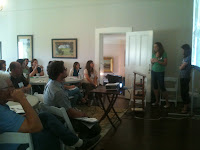by Jennifer Thomas
It is funny how little time we have as museum professionals
to actually visit museums! That’s why
Christina and I were so grateful to be able to take a day out of the VAM office
earlier this week and make our way to two member museums to see how they are
doing.
Our first stop was the Robert Russa Moton Museum in
Farmville. The museum is housed in a
1938 African American high school, one that was distressingly overcrowded the
day that the entire student body went on strike in 1951 and began their trek toward
being among the plaintiffs in Brown v. Board of Education. The school is an emotional space in its own
right, but the new permanent exhibition (designed by VAM business member StudioAmmons, Inc.) brings the amazing story of
these students to life in such an evocative way. I loved how the exhibition incorporated the
original blackboards and classroom elements to help tell the story:
Our second stop of the day was the Museum of the Confederacy in Appomattox. Opened just last year,
the building in Appomattox was designed to better showcase some of the key
artifacts from the Museum’s collection that relate to the final battles of the
Civil War and Lee’s surrender. The
exhibit space, here, too, was very well done, with signature artifacts
complemented by both low-tech interactive elements and high tech touch
screens. I was impressed at the care
that was taken to make this history personal—all of the uniforms on display
were tied to a specific person, whose photo and story were shown as well. The museum isn’t about the battles of the
war, but instead about the emotion and strategy that existed in the days
immediately leading to the surrender, and what happened to the citizens and
soldiers of the former Confederacy after the war. The design and installation here were also
done by VAM business members (Riggs Ward Design, and Explus, Inc.).
This graphic
illustrated the migrations of former soldiers and slaves that happened after
the end of the war.
Though it never occurred to me that visits to these two
disparate sites could complement each other, that is in the end exactly what
happened. Both exhibitions focused so
much on the voices of the main figures involved that you could hear the same
language repeated across generations.
The words of the white segregationists who fought Brown v. Board of
Education eerily echoed those of the Confederate politicians and soldiers from
the Civil War. Both spoke passionately
of states’ rights, and freedom, and the potential damage to their way of
life. Both also brought to mind some of
the statements made by Tea Party politicians today. If two short museum visits can enlighten
someone who has been in the history field for over 15 years, imagine what they
could do for the general public!






























